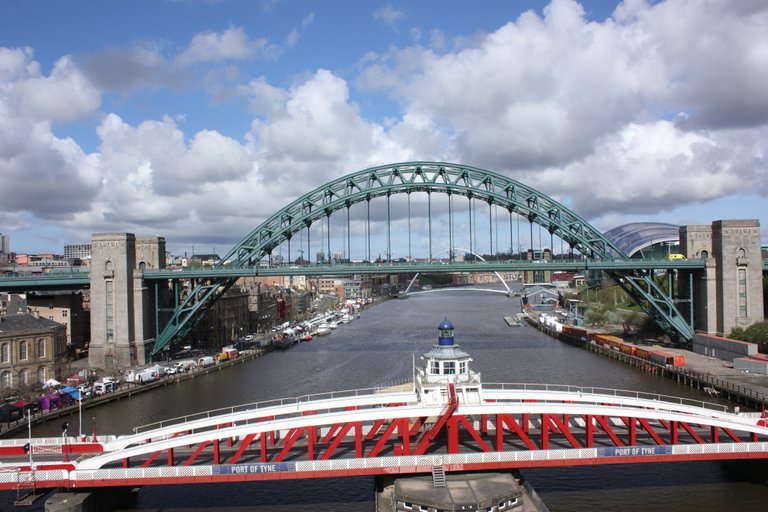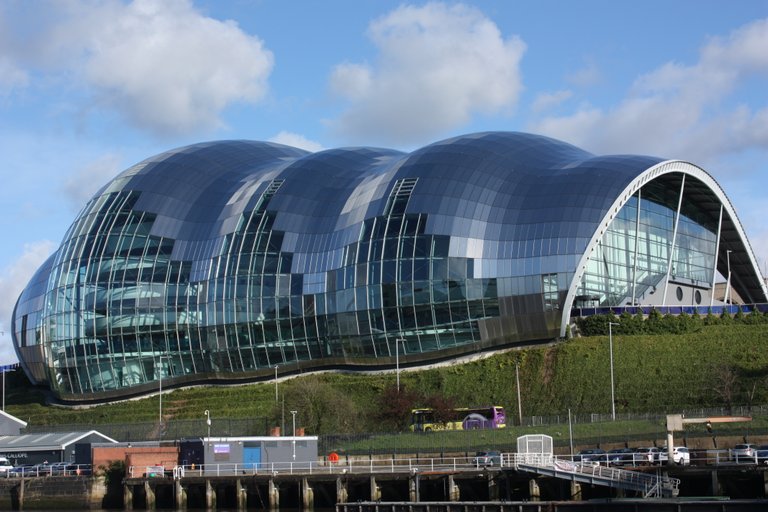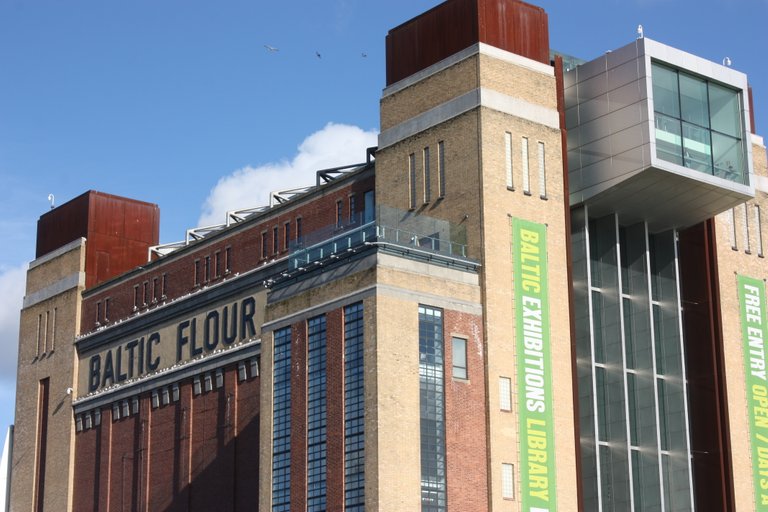There’s a lovely view of the Tyne Bridge and the Swing Bridge from The High Level Bridge with the Gateshead Millennium Bridge in the distance. The Queen Elizabeth II Metro Bridge is behind you. Two other bridges are further upstream - The King Edward VII bridge and the Redheugh Bridge. Facing downstream, The Sage Centre is on the right-hand side in Gateshead with the Baltic Flour Mill in the distance on the same side of the Tyne. The Quayside to the left-hand side is on the northern side of the Tyne in Newcastle and the opposite side of the river is Gateshead. The High Level bridge carries both rail and road traffic.
Tyne Bridge is the main symbol of Newcastle, a through arch bridge started in August 1925 and completed in February 1928, home to around 700 pairs of kittiwakes, at least one of which will appear in all your photos. The bridge is 85 feet above the Tyne and the single arch span is 531 feet, though the whole length of the entire bridge is 1,276 feet. The bridge was officially opened by King George V and he and his queen, Mary of Teck, were the first people to be driven across it in their carriage. 20,000 children were given the day off school to witness this spectacle. Today the bridge carries the A167 across the Tyne.
The Sage Centre in Gateshead, or Sage Gateshead, designed by Norman Foster and Partners, formed the heart of an ambitious regeneration project of Gateshead’s river frontage and lies alongside the Baltic Centre for Contemporary Art and the Tyne Bridge, whose arch is echoed in the Sage’s roof. In different lights, it can look like a chrysalis, a billowing steel cloud, or a grounded, deflating airship. It was completed in 2004 and is home to The Northern Sinfonia and a base for Folkworks, which promotes folk, jazz and blues performances. There are three auditoria and accommodation for the Regional Music School. The largest of the main performance spaces is an acoustically state-of-the-art concert hall seating up to 1,650 people. The second hall can be arranged to suit folk, jazz and chamber performances and seats up to 400. Sage Gateshead is constructed from steel, aluminium, and glass and the surface reflections of the sky endlessly change as you walk by on your way to the Baltic Centre. But first make sure you have a good look at the sweeping majesty of The Millennium Bridge.
This bridge was lifted into place as a complete structure by one of the world's largest floating cranes on 20 November 2000. It was opened to the public on 17 September 2001 and dedicated by Queen Elizabeth II on 7 May 2002. The bridge cost £22m to build. Six 18-inch diameter hydraulic rams (three on each side) rotate the bridge back on bearings to allow ships and boats up to 82 feet in height to pass underneath. The bridge takes as little as 4.5 minutes to rotate through the full 40° from closed to open depending on the speed of the prevaling wind. The bridge’s appearance during this manoeuvre has led to it being nicknamed the "Winking Eye Bridge" or “Blinking Eye Bridge”. The design is so energy efficient it costs only around £4 each time it opens. The soaring arch and supporting guy ropes almost make it look like a distorted, white harp from certain angles.
The Baltic Centre for Contemporary Art (also known as The Baltic, or Baltic Mill) is a centre for contemporary art on the Gateshead side of the Tyne. The Baltic Flour Mill was built by Rank Hovis to a late-1930s design and completed in 1950. An animal feed mill was added in 1957. The mill was closed in 1981, but along with a number of mills located along the banks of the Tyne, it remained a prominent local landmark. A large mill owned by the CWS and located just upstream of Dunston Staithes is now occupied by a residential development, so you see how easy it is to lose history. Thankfully, this fate didn’t befall the Baltic Mill. Dominic Williams of Ellis Williams Architects won an architectural design competition in the mid-1990s to convert the Baltic Mill into a centre for art. After ten years in the planning and a capital investment of £50m, including £33.4m from the Lottery Fund, the Baltic Mill re-opened, this time as an art centre, at midnight on Saturday 13 July 2002. There are no permanent exhibitions at The Baltic, no permanent collection of Modern Art, so everything is changing.
Another interesting cultural experience is a little way from The Quayside in Newcastle near the train station on Westgate. The Literary and Philosophical Society was founded in 1793 as a "conversation club" by the Reverend William Turner and others – more than fifty years before the London Library – the annual subscription was originally one guinea. The library contained works in French, Spanish, German and Latin and its members debated a wide range of issues, but religion and politics were prohibited. Women were first admitted to the library in 1804. During the 19th Century the Lit & Phil hosted people such as engineer and inventor George Stephenson who showed his miner's lamp here. In 1879, when Joseph Swan demonstrated his electric light bulbs, the Lit and Phil building became the first public building to be so illuminated. The Society received in 1800 the country's first specimens of the wombat and the duck-billed platypus from John Hunter, Governor of New South Wales. Between 1822 and 1825, a new building was created for the Society on Westgate Road where visitors can still visit the library today. People come to study, read newspapers and magazines (remember them?), and also chat around one of the communal tables. People with laptops are catered to and there’s even a long rectangular table at one end where people can study and type away in comfort. There’s tea available. The entrance way is particularly impressive.
Past Presidents of the Lit & Phil include Robert Stephenson the Victorian railway engineer, Charles Parsons inventor of the steam turbine, and GM Trevelyan the writer and historian. Famous members have included Thomas Bewick, James Audubon, Joseph Swan, Neil Tennant, though this is the American philosopher of that name rather than the member of The Pet Shop Boys who was born in nearby North Shields, and J Thomas Looney the man who first proposed the Oxfordian theory regarding the authorship of Shakespeare’s plays namely that Edward de Vere, 17th Earl of Oxford (1550–1604) wrote them all.
As I hope you know the term Geordie refers to someone born in the Newcastle area, and it’s the local variant of Georgie or George, but it’s derivation is unclear or at least there are two competing ideas. The first is that it started because of Newcastle’s support for either George I in the first Jacobite Rebellion of 1715 or for George II in the second Jacobite rebellion of 1745. Alternatively, it might have started because of the local miner’s preference for the miner’s lamp produced by George Stephenson as opposed to the safety lamp produced by Sir Humphrey Davy.




